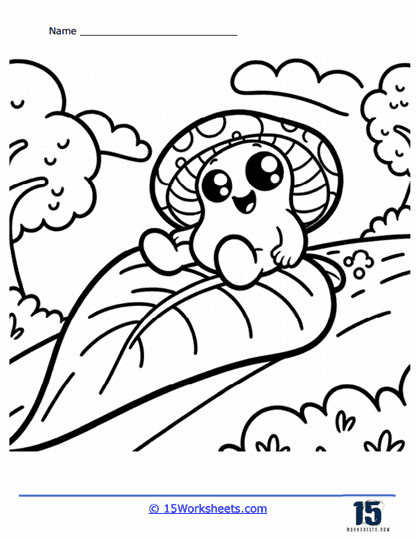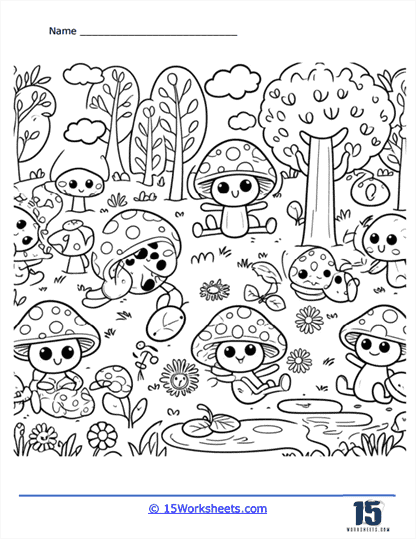Mushroom Worksheets
About These 15 Worksheets
Mushroom coloring pages offer a rich and varied canvas for creativity. From realistic forest scenes to whimsical, magical settings, these pages provide endless opportunities for coloring enthusiasts of all ages. The diverse elements found in mushroom coloring pages—such as different types of mushrooms, forest settings, seasonal themes, and additional whimsical or natural details—make them an engaging and educational activity. By using a wide range of colors and techniques, colorists can bring these enchanting scenes to life, enjoying the therapeutic and imaginative process of coloring.
Mushroom coloring pages are artistic illustrations designed for coloring that feature various types of mushrooms as the central theme. These pages can vary greatly in complexity, from simple outlines suitable for young children to intricate designs that appeal to older kids and adults. Mushroom coloring pages often include a variety of additional elements such as forest scenery, whimsical characters, and other elements of nature, making them a versatile and engaging coloring activity. These pages offer an enjoyable way for individuals to explore their creativity while also learning about the different species of mushrooms and their natural habitats.
When it comes to mushroom coloring pages, one can expect to encounter a wide array of mushroom species, each with its unique shape, size, and pattern. Common types of mushrooms that might appear on these coloring pages include Amanita mushrooms, known for their bright red caps with white spots, and often depicted in fairy tales and fantasy settings. Chanterelles, with their distinctive wavy caps, add a splash of color to any scene with their yellow or orange hues. Morels, featuring a honeycomb-like structure, are popular among mushroom enthusiasts for their intricate patterns. Fly Agaric, another name for Amanita muscaria, is the classic red-and-white mushroom often associated with magical forests. Button mushrooms, frequently depicted in realistic settings like kitchens or markets, are shown in clusters perfect for practicing shading techniques. Oyster mushrooms, with their layered, fan-like appearance, add a unique texture to any illustration.
Mushroom coloring pages often place these fungi in their natural habitats, typically lush forest settings. These environments provide a rich backdrop for the mushrooms and can include various elements such as towering trees, ferns, and bushes, creating a dense, leafy background. The forest floor might be depicted with fallen leaves, twigs, and other plants like moss and small flowers, adding realism and engagement to the scene. Logs and stumps, where mushrooms often grow, add texture and depth to the illustrations. Additionally, wildlife such as squirrels, rabbits, deer, and birds might be included to create a lively ecosystem, providing an opportunity to use a variety of colors and patterns.
In addition to realistic forest settings, mushroom coloring pages often incorporate whimsical elements that add a magical or fairy-tale quality to the illustrations. Small magical creatures like fairies, gnomes, or elves might be depicted interacting with the mushrooms, sitting on mushroom caps, dancing around them, or using them as homes. The forests might be depicted with an ethereal quality, featuring glowing mushrooms, enchanted trees, and mystical creatures like unicorns or dragons. Some coloring pages might feature mushrooms transformed into tiny houses with doors, windows, and chimneys, especially popular in fairy-tale themed coloring books.
Mushroom coloring pages can also reflect different seasons, providing a variety of color palettes and settings. Spring-themed mushroom coloring pages might include blooming flowers, butterflies, and bright, fresh greenery, with vibrant and cheerful colors reflecting the renewal of life. Summer scenes might depict mushrooms in dense, lush forests with abundant foliage and sunlight filtering through the trees, with animals and insects more prominent, adding to the vibrancy of the scene. Fall is a popular season for mushroom illustrations due to the beautiful colors of the leaves. Mushrooms might be shown among fallen leaves, with shades of orange, yellow, and red dominating the scene, perfect for practicing blending and shading techniques. Winter-themed pages might depict mushrooms peeking through the snow or growing on snow-covered logs, with the contrast between the white snow and the colorful mushrooms creating a striking image, often using cooler color palettes with blues, whites, and muted tones.
To make the mushroom coloring pages more engaging, various additional elements can be included. Insects like butterflies, ladybugs, and bees can add life to the illustrations, with these small details colored in bright, contrasting hues to stand out against the forest backdrop. Water features like streams, ponds, and waterfalls add a serene and dynamic element to the scene, with these water features colored in various shades of blue and green, with reflections and ripples adding complexity. Rocks and stones can add texture to the forest floor, with these elements helping to develop an understanding of shading and the use of different grays and browns. Sky elements like the sun, clouds, rainbows, or even a starry night sky provide a wider range of colors and enhance the overall scene. Fantasy elements like magical portals, glowing orbs, or enchanted objects make the coloring pages more imaginative and fun.
















